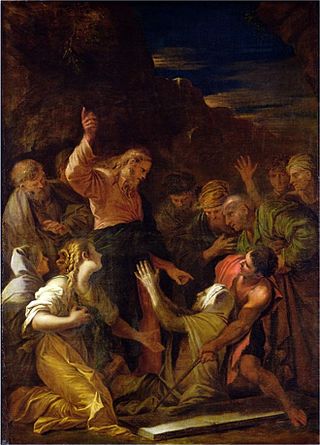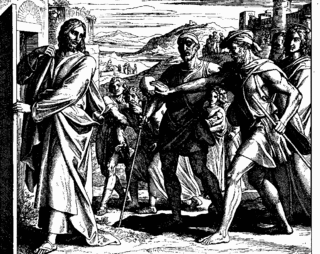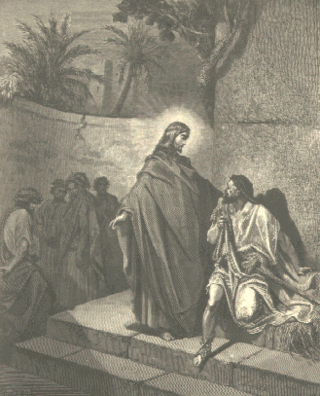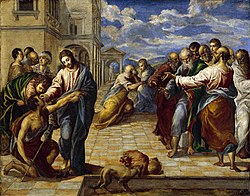John 9 is the ninth chapter of the Gospel of John in the New Testament of the Christian Bible. It maintains the previous chapter's theme "Jesus is light", recording the healing of a man who had been blind from birth, a miracle performed by Jesus, and their subsequent dealings with the Pharisees. The man born blind comes to complete faith in Jesus, while some of the Pharisees remain in their sin. The author of the book containing this chapter is anonymous, but early Christian tradition uniformly affirmed that John composed this Gospel.

Matthew 9:3 is a verse in the ninth chapter of the Gospel of Matthew in the New Testament.

Matthew 9:5 is a verse in the ninth chapter of the Gospel of Matthew in the New Testament.

Matthew 9:6 is the sixth verse in the ninth chapter of the Gospel of Matthew in the New Testament.
Matthew 9:28 is a verse in the ninth chapter of the Gospel of Matthew in the New Testament.
Matthew 9:24 is a verse in the ninth chapter of the Gospel of Matthew in the New Testament.
Matthew 9:30 is a verse in the ninth chapter of the Gospel of Matthew in the New Testament.
Matthew 9:33 is a verse in the ninth chapter of the Gospel of Matthew in the New Testament.
Matthew 9:34 is a verse in the ninth chapter of the Gospel of Matthew in the New Testament.

Matthew 12:11 is the eleventh verse in the twelfth chapter of the Gospel of Matthew in the New Testament.

Matthew 12:13 is the thirteenth verse in the twelfth chapter of the Gospel of Matthew in the New Testament.
Matthew 12:22 is the 22nd verse in the twelfth chapter of the Gospel of Matthew in the New Testament.

Healing the centurion's servant is one of the miracles performed by Jesus of Nazareth as related in the Gospel of Matthew and the Gospel of Luke. The story is not recounted in the Gospels of either John or Mark.

Jesus heals a man with a withered hand on the Sabbath in one of his miracles recounted in the Gospels, namely in Matthew 12:9-13, Mark 3:1-6, and Luke 6:6-11.

Jesus cleansing a leper is one of the miracles of Jesus. The story is found in all three of the Synoptic Gospels: Matthew 8:1–4, Mark 1:40–45 and Luke 5:12–16.

The exorcism of a boy possessed by a demon, or a boy with a mute spirit, is one of the miracles attributed to Jesus reported in the synoptic Gospels, involving the healing of a demonically possessed boy through exorcism. The account appears first in the Mark 9:17-29 and is repeated, slightly amended, in Matthew 17:14-21 and Luke 9:40-44. In the Gospel narratives, this healing takes place following the Transfiguration.

Jesus healing two blind men is a miracle attributed to Jesus in the Gospel of Matthew. It follows immediately on the account of the Daughter of Jairus.

Jesus exorcising a mute is the last of a series of miracles of Jesus recorded in chapter 9 of the Gospel of Matthew. It appears in Matthew 9:32–34, immediately following the account of Christ healing two blind men.
Matthew 11:4-6 is a set of verses in the eleventh chapter of the Gospel of Matthew in the New Testament.
Matthew 15:29-31 is a set of verses in the fifteenth chapter of the Gospel of Matthew in the New Testament.













